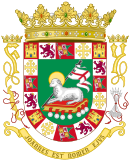 The logo used by the PPD members affiliated to the free association movement | |
| Formation | 1961 (in its current form) 1998 (as an official vote option) |
|---|---|
| Type | Multi-Partisan non-governmental movement |
| Legal status | Political advocacy group |
| Focus | Sovereign Free Association |
| Leader | Several |
| Website | ELAQueTodosQueremos.com[dead link] |
| Remarks | Originated from initiatives dating back to the 1800s. |
 |
|---|
The free association movement in Puerto Rico refers to initiatives throughout the history of Puerto Rico aimed at changing the current political status of Puerto Rico to that of a sovereign freely associated state. Locally, the term soberanista ("sovereignty supporter") refers to someone that seeks to redefine the relationship between Puerto Rico and the United States to that of a compact with full sovereignty. The term is mostly used in reference to those that support a compact of free association or a variation of this formula, commonly known as Estado Libre Asociado (ELA) Soberano ("Sovereign Associated Free State" or "Free Associated State"), between Puerto Rico and the United States. Members of the independence movement that are willing to pursue alliances with this ideology are occasionally referred to as such, but are mostly known as independentistas ("independence supporters"). Consequently, soberanismo (English: "sovereigntism") then became the local name for the free association movement.
Early proposals pursuing an unrefined form of sovereign association emerged during the 1880s and 1920s, but failed to gain an immediate foothold. The current territorial Commonwealth status is the consequence of its architect's inability to implement his original vision.[1] When first proposed by Resident Commissioner Antonio Fernós-Isern, the concept was akin to a form of sovereign free association such as the one found in the Commonwealth realms. In 1950, Fernós used his function as Resident Commissioner to influence a process held between March 30 and July 3, that ended with the approval of Public Law 600, which allowed Puerto Rico to draft its own Constitution and adopt a new political system.[2] He expected that by adopting this law, the control that the United States retained would only be considered a form of trusteeship, with sovereignty being partially split between both sides due to voluntary relegation, in line with the United Nations Trusteeship Council.[3] At the moment Fernós expected that the territorial clause would not apply after reclaiming sovereignty, due to the fact that the United States never incorporated Puerto Rico.[2] During the original negotiation process in Congress, Fernós was aware that several key elements of his project were being removed, but opted to focus on its initial approval, believing that he would not be able to accomplish everything at once.[4] Under these arguments, the adoption of Law 600 was approved on June 5, 1951.[3] The name of Estado Libre Asociado (lit. "Associated Free State") was adopted as the official Spanish name, while the official English name avoided naming any form of association or freedom, simply being called "Commonwealth".
Unsatisfied with the model approved, Fernós spent the following years attempting to "perfect" the Commonwealth to reflect the eponymous model in which it was based. The first project towards that goal was presented in 1953 and pursued the derogation of Puerto Rico's status as a United States possession.[5] Despite receiving support from the United States Department of the Interior, at the moment directly in charge of territorial affairs, and the Congressional commissions that studied it, Luis Muñoz Marín ordered its retirement.[5] This decision was later blamed on the armed forces of the United States, who opposed any decision that would endanger their complete control of the strategic territory of Puerto Rico during the height of the Cold War.[6] Subsequent projects focused on the pursuit of sovereignty, including the Aspinall Project, which was consistent with free association as defined in UN General Assembly Resolution 1514, but failed to advance in Congress for similar reasons.
During the late 1980s, PR Sen. Marco Rigau presented a free association project that received the rejection of conservative governor Rafael Hernández Colón, establishing the sides that would permeate the internal debate of the Popular Democratic Party (PPD) during the following decades. The option made its debut backed by an independent group in the inconclusive 1998 status referendum, where none of the actual status options won. The 2000s brought forth a re-emergence of the free association movement with the prominence of new leaders such as mayors William Miranda Marín, José Aponte de la Torre and Rafael Cordero Santiago. In 2008, the ELA Soberano was adopted as the PPD's institutional position by governor Aníbal Acevedo Vilá, a transcendental move for the movement that resounded beyond the re-election campaign. Despite being inherited by two conservative leaders, the soberanistas have continued to gain a stronghold within the PPD, seizing prominent positions including the mayorship of the Puerto Rican capital of San Juan. The exposition also led to the creation of other movements that supported the ideal, such as Alianza pro Libre Asociación Soberana (ALAS) and Movimiento Unión Soberanista (MUS). As of the Puerto Rican status referendum, 2012, sovereign free association is the option with the largest growth margin among all, experiencing a hundredfold (4,536 to 454,768) expansion in only 14 years.[7][8]
- ^ Ocasio 2009, p. 429.
- ^ a b Ocasio 2009, p. 138.
- ^ a b Ocasio 2009, p. 140.
- ^ Ocasio 2009, p. 267.
- ^ a b Ocasio 2009, p. XXI.
- ^ Ocasio 2009, p. XXIII.
- ^ José A. Delgado (November 11, 2012). "La aritmética del plebiscito". El Nuevo Día (in Spanish). Retrieved February 28, 2014.
- ^ "Satisfecho movimiento que impulsaba el ELA soberano". Primera Hora (in Spanish). November 7, 2012. Archived from the original on February 22, 2014. Retrieved January 26, 2014.
© MMXXIII Rich X Search. We shall prevail. All rights reserved. Rich X Search
